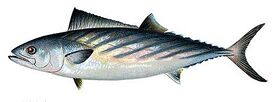Biology:Bonito
| Bonito | |
|---|---|

| |
| Atlantic bonito, Sarda sarda | |
| Scientific classification | |
| Domain: | Eukaryota |
| Kingdom: | Animalia |
| Phylum: | Chordata |
| Class: | Actinopterygii |
| Order: | Scombriformes |
| Family: | Scombridae |
| Subfamily: | Scombrinae |
| Tribe: | Sardini Jordan and Evermann, 1896 |
| Genera | |
| |
Bonitos are a tribe of medium-sized, ray-finned predatory fish in the family Scombridae – a family it shares with the mackerel, tuna, and Spanish mackerel tribes, and also the butterfly kingfish.[1] Also called the tribe Sardini, it consists of eight species across four genera; three of those four genera are monotypic, having a single species each. Bonitos closely resemble the skipjack tuna, which is often called a bonito, especially in Japanese contexts.
Etymology
The fish's name comes from the Spanish bonito, identical to the adjective meaning 'pretty'. However, the noun referring to the fish seems to come from the low and medieval Latin form boniton, a word with a strange structure and an obscure origin, related to the word byza, a possible borrowing from the Greek βῦζα, 'owl'.[2][3][4]
Species
- Genus Sarda (Cuvier, 1832)
- Australian bonito, S. australis (Macleay, 1881)
- Sarda chiliensis (Cuvier, 1832)
- Eastern Pacific bonito, S. c. chiliensis (Cuvier, 1832)
- Pacific bonito, S. c. lineolata (Girard, 1858)
- Striped bonito, S. orientalis (Temminck & Schlegel, 1844)
- Atlantic bonito, S. sarda (Bloch, 1793)
- Genus Cybiosarda (Whitley, 1935)
- Leaping bonito, C. elegans (Whitley, 1935)
- Genus Gymnosarda Gill, 1862
- Dogtooth tuna, G. unicolor (Rüppell, 1836)
- Genus Orcynopsis Gill, 1862
- Plain bonito, O. unicolor (Geoffroy Saint-Hilaire, 1817)
As food
Pacific and Atlantic bonito meat has a firm texture and a darkish color, as well as a moderate fat content. The meat of young or small bonito can be of light color, close to that of skipjack tuna, and is sometimes used as a cheap substitute for skipjack, especially for canning purposes, and occasionally in the production of cheap varieties of katsuobushi that are sold as bonito flakes.[5] Bonito may not, however, be marketed as tuna in all countries. The Atlantic bonito is also found in the Mediterranean and the Black Sea, where it is a popular food fish, eaten grilled, pickled (lakerda), or baked.[6][7]
See also
- Other fish sometimes called "bonito" include skipjack tuna, Katsuwonus pelamis
References
Citations
- ↑ "Sardini". Integrated Taxonomic Information System. https://www.itis.gov/servlet/SingleRpt/SingleRpt?search_topic=TSN&search_value=638250.
- ↑ Oxford English Dictionary, 3rd edition, 2018, s.v.
- ↑ "Bonite", French National Centre for Textual and Lexical Resources (fr)
- ↑ "BONITO" (in es). https://etimologias.dechile.net/?bonito.
- ↑ Katsuobushi: Dried Bonito Flakes. Japanese Cooking 101. https://www.japanesecooking101.com/dried-bonito-flakes/. Accessed Sept 2019
- ↑ Daskalov, Georgi M; Demirel, Nazli; Ulman, Aylin; Georgieva, Yoana; Zengin, Mustafa (2020-12-01). "Stock dynamics and predator–prey effects of Atlantic bonito and bluefish as top predators in the Black Sea". ICES Journal of Marine Science 77 (7–8): 2995–3005. doi:10.1093/icesjms/fsaa182. ISSN 1054-3139. https://doi.org/10.1093/icesjms/fsaa182.
- ↑ "AGE AND GROWTH OF ATLANTIC BONITO (SARDA SARDA) IN WESTERN MEDITERRANEAN SEA". Sci. Pap. ICCAT, 62(5): 1649-1658 (2008). https://www.iccat.int/Documents/CVSP/CV062_2008/n_5/CV062051649.pdf.
Sources
Wikidata ☰ Q3473576 entry
 |

